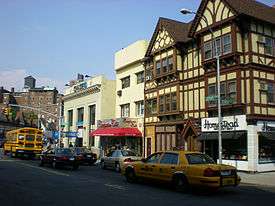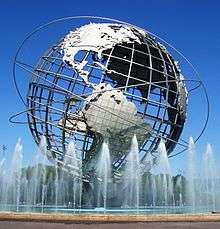Kew Gardens, Queens
| Kew Gardens | |
|---|---|
| Neighborhood of Queens | |
|
Homestead Gourmet Shop and other stores on Lefferts Boulevard | |
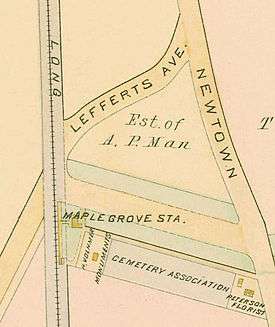 Map showing Maple Grove station in 1891 | |
| Country |
|
| State |
|
| City |
|
| County/Borough |
|
| Named for | Royal Botanic Gardens, Kew[1] |
| Population | |
| • Estimate (2008) | 25,769 |
| Ethnicity | |
| • White | 66.2% |
| • Black | 7.0% |
| • Hispanic | 20.0% |
| • Asian | 13.1% |
| • Other | 7.4% |
| Economics | |
| • Median income | $61,287 |
| ZIP code | 11415 |
| Area code(s) | 718, 347, 917 |
Kew Gardens is an upper-middle class neighborhood in the central area of the New York City borough of Queens. Kew Gardens, shaped roughly like a triangle, is bounded to the north by the Jackie Robinson Parkway (formerly the Interboro Parkway), to the east by Van Wyck Expressway and 131st Street, to the south by Hillside Avenue, and to the west by Park Lane, Abingdon Road, and 118th Street. Forest Park and the neighborhood of Forest Hills are to the west, Flushing Meadows–Corona Park north, Richmond Hill south, Briarwood southeast, and Kew Gardens Hills east.
History
Kew Gardens was one of seven planned garden communities built in Queens from the late 19th century to 1950.[2] Much of the area was acquired in 1868 by Englishman Albon P. Man, who developed the neighborhood of Hollis Hill to the south, chiefly along Jamaica Avenue, while leaving the hilly land to the north undeveloped.[3]
Maple Grove Cemetery on Kew Gardens Road opened in 1875. A Long Island Rail Road station was built for mourners in October and trains stopped there from mid-November. The station was named Hopedale, after Hopedale Hall, a hotel located at what is now Queens Boulevard and Union Turnpike. In the 1890s, the executors of Man's estate laid out the Queens Bridge Golf Course on the hilly terrains south of the railroad. This remained in use until it was bisected in 1908 by the main line of the Long Island Rail Road, which had been moved 600 feet (180 m) to the south to eliminate a curve. The golf course was then abandoned and a new station was built in 1909 on Lefferts Boulevard. Man's heirs, Aldrick Man and Albon Man Jr., decided to lay out a new community and called it at first Kew and then Kew Gardens after the well-known botanical gardens in England.[1] The architects of the development favored English and neo-Tudor styles, which still predominate in many sections of the neighborhood.
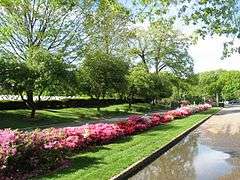
In 1910, the property was sold piecemeal by the estate and during the next few years streets were extended, land graded and water and sewer pipes installed. The first apartment building was the Kew Bolmer at 80–45 Kew Gardens Road, erected in 1915; a clubhouse followed in 1916 and a private school, Kew-Forest School, in 1918. In 1920, the Kew Gardens Inn at the railroad station opened for residential guests, who paid $40 a week for a room and a bath with meals. Elegant one-family houses were built in the 1920s, as were apartment buildings such as Colonial Hall (1921) and Kew Hall (1922) that numbered more than twenty by 1936.
In July 1933, the Grand Central Parkway opened from Kew Gardens to the edge of Nassau County; this road was extended in 1935 as the Interborough Parkway to Pennsylvania Avenue in East New York. Since the parkways used part of the roadbed of Union Turnpike, no houses were demolished. However, the greatest change was wrought by the opening of the Independent Subway System line along Queens Boulevard to Union Turnpike on December 31, 1936; four months later, the subway was extended to Jamaica, Queens. Residents could now reach Manhattan, Brooklyn, and the Bronx twenty-four hours a day for a five-cent fare, stimulating the construction of larger apartment buildings like Kent Manor and high-rise buildings along Queens Boulevard and the last vacant land disappeared.
Despite its historical significance, Kew Gardens lacks any landmark protection.[2]
In 1964, the neighborhood gained news notoriety when Kitty Genovese was murdered near the Kew Gardens Long Island Railroad station. A New York Times article reported that none of the neighbors responded when she cried for help.[4] The story came to represent the apathy and anonymity of urban life. The circumstances of the case are disputed to this day. It has been alleged that the critical fact reported by The New York Times that "none of the neighbors responded" was false. The case of Kitty Genovese is an oft-cited example of the bystander effect, and the case that originally spurred research on this social psychological phenomenon.[5]
In addition to Maple Grove Cemetery, the Ralph Bunche House is listed on the National Register of Historic Places and is also a designated National Historic Landmark.[6]
Area description
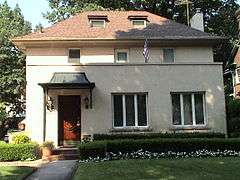
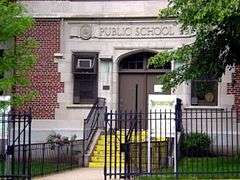
Kew Gardens remains a densely populated residential community, but Kew Gardens is increasingly becoming a upper class residential area, with a mix of one-family homes above the million-dollar range, complex apartments, co-ops and others converted and on the way or being converted as condominiums. A major five-star hotel is under development on 82nd Avenue, reflecting a modernization of the area. However, it is filled mainly with apartment buildings between four and ten stories high; while many are rentals, some are co-ops. Although there are no New York City Housing Authority complexes in Kew Gardens, Mitchell-Lama buildings provide stabilized rental prices for families or individuals who may need help paying rent. On 83rd Avenue there is a 32-story Mitchell-Lama building. Along the borders of Richmond Hill, Briarwood, and Jamaica, smaller attached houses exist. Many of these are two or three family homes. Expensive single family homes are located around the Forest Park area. Due to constant development, however, many owners are selling out their detached homes to developers who teardown and convert them into apartment housing. This has brought demographic change.
Surrounded by Forest Park, residents in Kew Gardens enjoy what many Manhattanites lack: greenery and quiet nights. The Park, which is very well preserved and is the third largest in Queens, has a private road where residents can jog or walk year round. There are some horse back riding paths and hiking paths actively used by residents. Frederick Law Olmsted conceived the design of the park.[7] Some of the Queens courthouses are also located in Kew Gardens on the side of Queens Boulevard.
The neighborhood also has many airline personnel because of its proximity to the Q10 to John F. Kennedy International Airport, as well as to Delta Air Lines and other airlines' special shuttles that serve pilots and flight attendants staying in Kew Gardens.
Kew Gardens's commercial center is Lefferts Boulevard between Austin Street and Metropolitan Avenue. This street is the home to many favorite spots, including Kew Gardens Cinemas with a selection of independent international films, Dani's Pizzeria, Austin's Steak and the Austin Ale House, and Comic Den. The county's civic center, Queens Borough Hall, along with one of the county criminal courts, stand at the northern end of the neighborhood, on Queens Boulevard, in a complex extending from Union Turnpike to Hoover Avenue.
Schools of note located in Kew Gardens include Yeshiva Tifereth Moshe, Bais Yaakov of Queens and Yeshiva Shaar Hatorah. P.S. 99, the local public school, has special programs for gifted students such as the Gifted and Talented program, where children start to learn advanced material beginning in second grade.[8]
Demographics

As of the 2000 U.S. Census, the demographics were 66.2% White, 13.0% Asian, 7.0% Black or African American, 0.3% American Indian and Alaska Native, 7.4% Other and Hispanic or Latino were 20.0% of the population. The neighborhood's demographics have since changed, however. The Hispanic and Asian populations have grown significantly over the past decade. In 2008, U.S. Census estimates placed the Kew Gardens population at more than 25,769.[9] Many of the residents are between the ages of 30 and 38, married, college graduates and renters.
Kew Gardens is ethnically diverse. A large community of Jewish refugees from Germany took shape in the area after the Second World War which is reflected still today by the number of active synagogues in the area. The neighborhood attracted many Chinese immigrants after 1965, about 2,500 Iranian Jews arrived after the Iranian Revolution of 1979, and immigrants from China, Pakistan, Iran, Afghanistan, Israel, the former Soviet Union, India, Bangladesh and Korea settled in Kew Gardens during the 1980s and 1990s. Currently, Kew Gardens has a growing population of Bukharian Jews from Uzbekistan, alongside a significant Orthodox Jewish community.[3] Also many immigrants from Central America, and South America call Kew Gardens home, as well as immigrants from Japan.
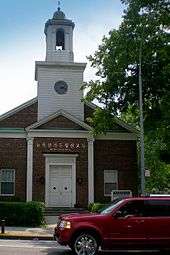
The increase of the Korean population followed the renovation and rededication of the First Church of Kew Gardens, which offers Korean-language services. In recent years, young professionals and Manhattanites looking for greenery, park-like atmosphere and spacious apartments have moved to the area.
Major development in the neighborhood, such as the construction of new apartment complexes and multi-family homes, has resulted in great demographic change as well. Immigrants from Latin America, Guyana, South Asia and East Asia, and the Middle East (especially Israel), have moved into these new developments. Even the local cuisine reflects this diversity in Kew Gardens, with Russian, Italian, Indian, Pakistani, and Uzbek dining available to residents and visitors. Food outlets include restaurants, delis, and markets. Small diners, Indian restaurants, Spanish restaurants, Caribbean restaurants, European and Arab Minimarkets, and Kosher delis line the streets of Kew Gardens. Many religious groups such as Jews, Muslims, and Hindus, can shop at local markets and bazaars that cater to their religious-food needs.
Economy
Kew Gardens has many locally owned businesses and restaurants especially on Lefferts Boulevard, Metropolitan Avenue, Austin Street, and Kew Gardens Road. The courthouse is very profitable, as is transportation to the area; however, neither profit the neighborhood directly, but instead serve as an incentive to move to the area. The cost of living in the neighborhood (as of 2015) is $62,900.[10] Pilots and flight attendants who stay in Kew Gardens in between John F. Kennedy International Airport and LaGuardia Airport flights also affect the local economy.
Saudi Arabian Airlines operates an office in Suite 401 at 80–02 Kew Gardens Road in Kew Gardens.[11]
Transportation

The neighborhood is accessible from Interstate 678 (Van Wyck Expressway), Grand Central Parkway, Jackie Robinson Parkway, Queens Boulevard, and Union Turnpike These all intersect at the Kew Gardens Interchange.[12]
Public transportation in the neighborhood are the Kew Gardens – Union Turnpike subway station (New York City Subway's E F trains), and Kew Gardens railway station (Long Island Rail Road's City Terminal Zone).[12] New York City Bus routes include Q10, Q37, Q46, Q54, Q60, and several express bus routes to Manhattan.[13]
Notable people
Notable residents of Kew Gardens include:
- Burt Bacharach (1928–) Award-winning pianist, composer and producer grew up in Kew Gardens.
- Crosby Bonsall (1921–1995) artist and children's book author and illustrator.[14]
- Maud Ballington Booth (1865–1948), Volunteers of America co-founder.[15]
- Joshua Brand, television writer, director and producer, grew up in Kew Gardens.[16]
- Ralph Bunche (1903–1971), diplomat and Nobel Peace Prize winner.[17]
- Charlie Chaplin, actor, lived at 105 Mowbray Drive in 1919–1922.[18]
- Rodney Dangerfield (1921–2004), comedian who lived above the Austin Ale House.[19]
- Rona Elliot, music journalist, grew up in Kew Gardens.[20]
- Mary Garfield, daughter of U.S. President James A. Garfield, lived in Kew Gardens at the turn of the 20th century.[21]
- Kitty Genovese, murder victim. Her 1964 murder in her home neighborhood of Kew Gardens was widely publicized.
- George Gershwin (1898–1937), composer.[22]
- Bernhard Goetz, best known for shooting four young black men on the subway in 1984.
- Miriam Hopkins (1902–1972), actress.[23]
- Rabbi Paysach Krohn, rabbi and author, currently lives in Kew Gardens.[24]
- Lucy Landau (1905-1990),character actress.
- Josef Lhevinne (1874–1944), concert pianist.[25]
- Robert H. Lieberman, filmmaker, grew up in Kew Gardens.[26]
- Saul Marantz (1911-1997), designed and built the first Marantz audio product at his home in Kew Gardens.[27]
- Peter Mayer, former Penguin Books CEO, grew up in Kew Gardens.[28]
- Anaïs Nin (1903–1977), author.[25]
- Dorothy Parker (1893–1967), poet.[22]
- Will Rogers, Sr. (1879–1935), actor.[22]
- Will Rogers, Jr. (1911–1993), congressman and son of Will Rogers, Sr..[18]
- Nelson Saldana, track cycling champion.
- Ossie Schectman (1919-2013), NBA basketball guard.
- Robert Schimmel (1950-2010), comedian, grew up in Kew Gardens.[29]
- Jerry Springer (born 1944), talk show host and former mayor of Cincinnati, Ohio.
- Carol Montgomery Stone (1915-2011), actress and daughter of actor Fred Stone, grew up in Kew Gardens.[18]
- Lisa Ysaye Tarleau (1878–1952), author.
Gallery
 Shops on Kew Gardens Road
Shops on Kew Gardens Road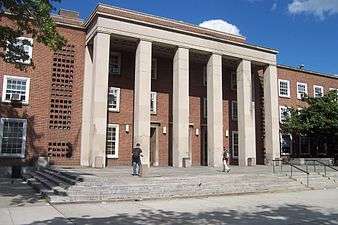 Queens Borough Hall
Queens Borough Hall Civic Virtue Statue on Queens Boulevard
Civic Virtue Statue on Queens Boulevard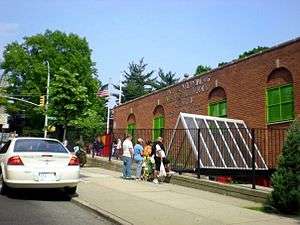 P.S. 99 school annex
P.S. 99 school annex Kew Gardens Post Office
Kew Gardens Post Office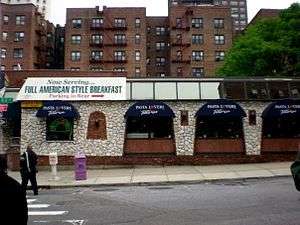 A restaurant in Kew Gardens; the adjacent site would become a five-star hotel
A restaurant in Kew Gardens; the adjacent site would become a five-star hotel
See also
-
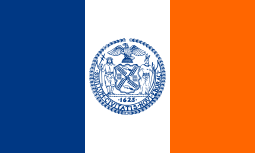 New York City portal
New York City portal
References
- 1 2 "Next to the L.I.R.R. Tracks; Five 2-Family Houses For Kew Gardens", The New York Times, April 24, 1994. Accessed September 27, 2010. "In 1909, when train service began on the Long Island Rail Road, the northerly section of the Man property was renamed Kew Gardens, also after a section of London."
- 1 2 "New York Real Estate: Kew Gardens", AM New York, August 28, 2008. Retrieved July 4, 2009.
- 1 2 Donovan, Aaron. " If You're Thinking of Living In/Kew Gardens, Queens; Small-Town Feeling at a Busy Crossroads", The New York Times, October 15, 2000. Retrieved October 9, 2007.
- ↑ A Picture History of Kew Gardens, NY – Kitty Genovese – The popular account of the Kitty Genovese murder is mostly wrong as shown by the evidence from her killer's trial and other sources Archived 3 April 2009 at the Wayback Machine.
- ↑ Dowd, Maureen (March 12, 1984). "20 years after the murder of Kitty Genovese, The question remains: Why?". The New York Times. p. B1. Retrieved July 5, 2007.
- ↑ National Park Service (2010-07-09). "National Register Information System". National Register of Historic Places. National Park Service.
- ↑ "Forest Park: History", New York City Department of Parks & Recreation, July 2009. Retrieved July 4, 2009.
- ↑ "P.S. 99 Kew Gardens School", Inside Schools, September, 2006. Retrieved July 4, 2009.
- ↑ "Kew Gardens—Quiet and Leafy Location", Queens Chronicle, June 12, 2008. Retrieved July 4, 2009.
- ↑ http://www.realtor.com/local/Kew-Gardens_New-York_NY
- ↑ "Ministry Addresses in the U.S.." Embassy of Saudi Arabia Washington D.C. Retrieved on January 5, 2008.
- 1 2 "MTA Neighborhood Maps:Kew Gardens" (PDF). mta.info. Metropolitan Transportation Authority. 2015. Retrieved 30 June 2015.
- ↑ http://web.mta.info/nyct/maps/busqns.pdf
- ↑ "Crosby Bonsall, 74, Children's Author". The New York Times (Obituaries). The New York Times Company. 20 January 1995. Retrieved 31 March 2015.
- ↑ "GIFT TO MAUD B. BOOTH.; Charles D. Stickney Leaves Residuary Estate to Head of Volunteers.", The New York Times, March 31, 1916. Accessed July 5, 2009. "Charles Dickinson Stickney, a prominent lawyer of this city, who died on March 8, did not provide in his will for twelve first cousins, two second cousins, and one aunt, but bequeathed his entire residuary estate to Mrs. Maud Booth, widow of Ballington Booth and head of the Volunteers of America, who lives in Kew Gardens, L.I."
- ↑ Chan, Sewell. "Nazi Refugees’ Son Explores Complex Feelings", New York Times, April 22, 2009. Accessed July 5, 2009. "Growing up in Kew Gardens, Queens, in the 1940s and '50s, the children of Jewish refugees from Central Europe did not always feel different...Joshua Brand, the writer and producer, a creator of the television hits "St. Elsewhere" and "Northern Exposure"; the architectural historian Barry Lewis."
- ↑ Rimer, Sara. "From Queens Streets, City Hall Seems Very Distant", The New York Times, October 19, 1989. Retrieved November 13, 2007.
- 1 2 3 Hart, May Gleason. "Kew Gardens of Today – A Far Cry from 50 years Ago", Community News, January, 1966. Accessed July 5, 2009. "We have had many prominent people reside in Kew Gardens. Wil [sic] Rogers and his family lived on the opposite corner. Will Rogers, Jr., Mary and Jimmie were my daughter Jeanne's play and schoolmates and were frequently joined by Paula and Carol Stone, daughters of the famous musical comedy star, Fred Stone."
- ↑ Christon, Lawrence. "THE EDUCATION OF RODNEY DANGERFIELD", Los Angeles Times, July 1, 1986. Accessed April 1, 2008. "Perhaps school talk reminded him of growing up in New York's Kew Gardens, where, as a boy named Jacob Cohen, he had an entertainer father who didn't use the family name (he billed himself as Phil Roy and when Dangerfield went into show business as a comedian, he used the moniker Jack Roy)."
- ↑ Chan, Sewell. "Nazi Refugees’ Son Explores Complex Feelings", New York Times, April 22, 2009. Accessed July 5, 2009. "Growing up in Kew Gardens, Queens, in the 1940s and '50s, the children of Jewish refugees from Central Europe did not always feel different...the pop music critic Rona Elliot; Joshua Brand, the writer and producer, a creator of the television hits "St. Elsewhere" and "Northern Exposure"; the architectural historian Barry Lewis; and, to be sure, countless lawyers and doctors."
- ↑ Hart, May Gleason. "Kew Gardens of Today – A Far Cry from 50 years Ago", Community News, January, 1966. Accessed July 5, 2009. "We have had many prominent people reside in Kew Gardens... Mrs. Stanley Brown, President Garfield's daughter, who taught me how to make buttonholes. The idea for the first World's Fair of 1938 was hatched on the sun porch of John B. Burton, our next door neighbor, who was given Queens' Most Prominent Citizen Award. "
- 1 2 3 Bortolot, Lana. "New York Real Estate: Kew Gardens, Queens", AM New York, August 28, 2008. Accessed July 5, 2009. "The neighborhood's nickname, "Crew Gardens," is a nod to the many airline personnel living here, but Kew Gardens has always been home to the jet set: Charlie Chaplin, Will Rogers, Dorothy Parker and George Gershwin were among the artistic community that settled here in the 1920s."
- ↑ Lewis, Barry. "Kew Gardens: Urban Village in the Big City", April 30, 1999. Accessed July 5, 2009. "Kew Gardens, a village in Queens about twelve miles (19 km) from Manhattan, has been home to movie stars and Broadway performers (Charlie Chaplin, Miriam Hopkins, and Will Rogers), authors (Anaïs Nin and Dorothy Parker), and even Nobel Prize winners (Ralph Bunche). In many ways it has been a community ahead of its time."
- ↑ "The Mohel", July, 2009. Accessed July 5, 2009. "He lives in Kew Gardens, NY with his wife Miriam and takes great pride in his family. ."
- 1 2 "Neighborhood at Risk: Kew Gardens", Historic Districts Council, July 2009. Accessed July 5, 2009. "Kew Gardens became the home of an artistic and intellectual set. In the 1910's and 1920's, neighbors included film and stage stars, writers, musicians, and artists such as Charlie Chaplin, Will Rogers, Anaïs Nin, Dorothy Parker, Joseph Lhevinne, and George Gershwin."
- ↑ Chan, Sewell. "Nazi Refugees’ Son Explores Complex Feelings", New York Times, April 22, 2009. Accessed July 5, 2009. "Growing up in Kew Gardens, Queens, in the 1940s and '50s, the children of Jewish refugees from Central Europe did not always feel different...Such are the themes of "Last Stop Kew Gardens," a 54-minute semiautobiographical documentary by Robert H. Lieberman, 68, a senior lecturer in physics at Cornell who has branched out into novels and films."
- ↑ Johnson, Lawrence B. "Saul B. Marantz, 85, Pioneer In Hi-Fi Audio Components", The New York Times, January 23, 1997. Accessed August 7, 2016. "After service in the Army during World War II, Mr. Marantz and his wife, Jean Dickey Marantz, settled in Kew Gardens, Queens."
- ↑ Chan, Sewell. "Nazi Refugees’ Son Explores Complex Feelings", New York Times, April 22, 2009. Accessed July 5, 2009. "Michael Nussbaum, a lawyer, and Peter Mayer, the former chief executive of Penguin Books, both recall their acute embarrassment about their German-speaking parents, who sounded just like the Nazis in postwar American films."
- ↑ Krawitz, Alan. "Kew Gardens — Quiet And Leafy Location", Queens Chronicle, June 12, 2008. Accessed July 5, 2009. "Notable former residents of Kew Gardens include Will Rogers and most recently daytime talk host Jerry Springer. In addition, Kew Gardens has been the subject of numerous books and films, including Barry Lewis' 1999 book, "Kew Gardens: Urban Village in the Big City," and Robert Lieberman's film "Last Stop Kew Gardens," featuring Springer, Josh Brand and comedian Robert Schimmel."
External links
| Wikimedia Commons has media related to Kew Gardens, Queens. |
- Unofficial Kew Gardens website
- A Picture History of Kew Gardens
- Kew Gardens Civic Association
- Kew Gardens Synagogue
Coordinates: 40°42′20.32″N 73°49′37.7″W / 40.7056444°N 73.827139°W
